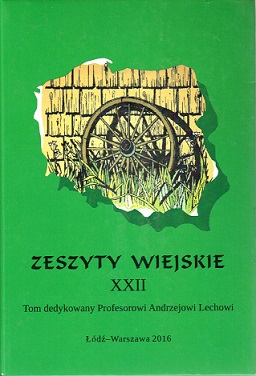Tradycyjne formy transportu na ziemiach polskich. Przenoszenie różnych brzemion siłami ludzi w pierwszej połowie XX wieku
DOI:
https://doi.org/10.18778/1506-6541.22.06Słowa kluczowe:
transport w Polsce, wieś europejska, wieś polska, Polska I poł. XX w.Abstrakt
A man had been carrying various loads for ages. It was a few thousand years ago that after spreading of agriculture and sedentary lifestyle as well as domestication of cattle, horses and donkeys, new methods of transportation including pack, land and vehicular transport appeared. In spite of that, it was until the first half of the 20th century that country inhabitants started to carry various loads, usually within their farms and on the way to or from the field or forest as well as to carry products for sale to market in town. They used different baskets (see the map), other woven containers and loops, sheets, bags to carry weights on their back. There were also itinerant sellers and manufacturers who reached the country while travelling through the vast areas of central Europe and they mostly used baskets and chests carried on their backs. Using an ethno-geographic method based on materials collected in the Studio of the Polish Ethnographic Book of Maps and numerous maps, the author describes the dynamics of cultural changes, disappearance of some ways and tools that served to carry things (containers made of bark, nets stretched on arches, water-jugs and wooden buckets and many others) and emergence of new tools. The changes happen in the pace set by the country economy, e.g. following potato cultivation big baskets appeared. Such innovations and others usually came from the west, whereas archaisms and relics mostly were observed in the north-eastern part of Poland.
Pobrania
Bibliografia
A. Paládi-Kovács, Einige Bemerkungen über die Traggeräte der ungarischen Bauernschaft, [w:] Studia ethnographica et folkloristica in honorem Béla Gunda, red. J. Szabadfalvi, Z. Ujváry, Műveltség és Hagyomány, XIII–XIV, 1971, ryc. 1 (mapa) na s. 412.
Google Scholar
M.S. Gluško, Šlâchi spolučennâ i transportni zasobi v Ukraïns’kich Karpatach drugoï polovini XIX – poč. XX st., Naukova Dumka, Kiïv 1993, s. 71–72 i ryc. 5 na s. 60.
Google Scholar
Z. Kłodnicki, Reliktowe formy transportu…, tabl. XXVII po s. 134.
Google Scholar
K. Novákova, Tradičné spôsoby prepravy detí v Európe a podoby ich súčasnej revitalizácie, „Ethnologia Europae Centralis”, t. X, 2011, s. 55–63.
Google Scholar
P. Scheuermeyer, Bauernwerk in Italien, der italienischen und rätoromanischen Schweiz, t. I, Erlenbach–Zürich 1943.
Google Scholar
R. Reinfuss, Wełniane torby góralskie, „Polska Sztuka Ludowa” 1949, nr 3–4, s. 112–119
Google Scholar
B. Kopczyńska-Jaworska, Wollene Hirtentaschen in den Karpaten – ein Beitrag zur Kenntnis der Transportmittel und Transportarten in der Almwirtschaft in den Karpaten, „Folkelivs Studier”, t. 4 (Land Transport in Europe), København 1973, s. 325–346.
Google Scholar
E.V. de Oliveira, F. Galhano, B. Perejra, Alfaia agrícola Portugesa, Lisboa 1976, s. 340–344.
Google Scholar
J. Gajek, Kwestionariusz nr 5…, s. 44, 64, 72.
Google Scholar
Z. Kłodnicki, Transport siłami ludzkimi, [w:] Transport i komunikacja lądowa, Komentarze do Polskiego Atlasu Etnograficznego, t. IV. Wrocław 1997, s. 9–109.
Google Scholar
K. Zielnica, Wyprowadzanie zmarłego na cmentarz, [w:] Polski Atlas Etnograficzny, red. J. Gajek, Z. VII (przygotowany do druku w 1976): Karta CCXIX, mapa 415.
Google Scholar
B. Jankowska, Kołyski wiszące używane na wolnym powietrzu, [w:] Polski Atlas Etnograficzny, red. J. Gajek, Z. V, Warszawa 1974, karta CLV, mapa 296.
Google Scholar
K. Moszyński, Niektóre przyczyny zróżnicowania kultury ludowej w Polsce, nadbitka z „Ludu Słowiańskiego”, t. IV, z. 1, 1937, s. 65, B-117; B.Z. Kłodnicki, Polska – pogranicze zachodniej i północno-wschodniej prowincji kulturowej w Europie (na podstawie Polskiego Atlasu Etnograficznego), „Ethnologia Europae Centralis”, t. 9, 2009, s. 45–59.
Google Scholar
Z. Kłodnicki, Karta CXLI Zanikające formy transportu nasobnego i ręcznego: mapa 274 Płachty do transportu nasobnego, [w:] Polski Atlas Etnograficzny, z. V, red. J. Gajek, Warszawa 1974.
Google Scholar
H. Cękalska-Zborowska, Wieś w malarstwie i rysunku naszych artystów, Ludowa Spółdzielnia Wydawnicza, Warszawa 1974.
Google Scholar
Pobrania
Opublikowane
Jak cytować
Numer
Dział
Licencja

Utwór dostępny jest na licencji Creative Commons Uznanie autorstwa – Użycie niekomercyjne – Bez utworów zależnych 4.0 Międzynarodowe.











